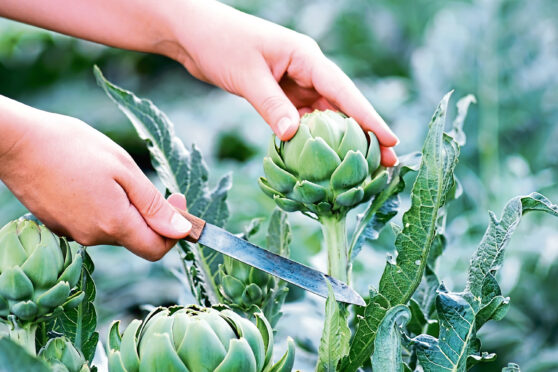
Lupins are a classic plant of cottage gardens and they come in a huge range of colours. Plant them somewhere that they will get full sun and increase their numbers by taking basal cuttings in spring.
If you don’t have much space for veg then it makes sense to grow those kinds that cost a lot or taste delicious if picked and cooked within minutes. Two of the best are asparagus and artichokes, both of which are pricey to buy in the supermarket and which are at their best when really fresh.
Asparagus is a little bit tricky. It needs very free-draining soil and rigorous weeding, and it takes two years from planting until you get a crop. Even then, the cropping period is limited to about six weeks between May and June, which is a short period when you consider how much space asparagus takes up on the plot.
Artichokes can be grown in the flower border, thanks to their handsome appearance, but they do need a little bit of frost protection and again good, free-draining soil is essential. The trick to getting a good crop is to remove the first bud that appears, as this will then promote further buds to develop lower down the plant.
Artichokes are hungry plants so a liquid feed every two weeks helps to keep them in good health, and it is important to give them a good drink of water during dry spells. Also, the plants don’t remain productive for very long, but the suckers that pop up can be grown on to provide a continuous supply of replacements.
Even without a lot of space it is worth growing some early potatoes, simply because they taste so good. If you’ve been growing these then you should be harvesting them now, enjoying them smothered in butter or sliced cold in salads with lashings of mayonnaise. You can grow them in a large container or in old compost sacks so make a note to get these in the ground next April if you want to enjoy one of the best tastes that summer has to offer.
Sweetcorn that was planted in May won’t be ready until August at the earliest but this must be the ultimate “cook it quick” vegetable as very rapidly after picking the sugars that give it its sweet taste quickly turn to starch.
Deep, fertile soil in sunshine is essential for good sweetcorn so if you have poor soil then start working now on building up its humus content so that when sowing time next year you will have a good base for growing this delicious crop.

Enjoy the convenience of having The Sunday Post delivered as a digital ePaper straight to your smartphone, tablet or computer.
Subscribe for only £5.49 a month and enjoy all the benefits of the printed paper as a digital replica.
Subscribe